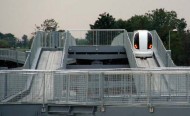 Exide Technologies is helping make the world’s first Personal Rapid Transit System a reality. ULTra (Urban Light Transport) has recently started operational testing at Heathrow airport. It will use a fleet of 21 low power driverless electric vehicles on a dedicated guideway route network. It will initially transfer passengers from the Business Car Park to Terminal 5. The system began development in 1995 and has had £25m worth of investment to date. Exide became involved in around 1998 and were instrumental in determining the optimum way of ensuring sufficient capacity is maintained within the batteries. A Partial State Of Charge (PSoC) system was developed and thoroughly tested at Exide’s Over Hulton facility.
Exide Technologies is helping make the world’s first Personal Rapid Transit System a reality. ULTra (Urban Light Transport) has recently started operational testing at Heathrow airport. It will use a fleet of 21 low power driverless electric vehicles on a dedicated guideway route network. It will initially transfer passengers from the Business Car Park to Terminal 5. The system began development in 1995 and has had £25m worth of investment to date. Exide became involved in around 1998 and were instrumental in determining the optimum way of ensuring sufficient capacity is maintained within the batteries. A Partial State Of Charge (PSoC) system was developed and thoroughly tested at Exide’s Over Hulton facility.
Advanced Transport Systems Ltd (ATS) , the developers of ULTra wanted to use the latest technology – largely derived from the automotive industry – employing ‘off the shelf’ systems and components to ensure an efficient and financially viable transport solution. Four adult passengers with luggage travel comfortably non-stop to their chosen destination in a personal vehicle. Sophisticated software and the use of stations separate from the main network ensure that they usually wait no more than 15 seconds for the next vehicle. The maximum speed is 25mph (40kph), meaning that journey times are faster and more energy efficient than cars because there is no stop-starting.
Exide Technologies has supplied 4x 45Ah spiral wound batteries per vehicle. This design of battery gives a greater surface area of positive and negative plate within the cell and is the most efficient way of liberating the stored energy from a lead acid battery. These AGM batteries suspend the electrolyte in a glass microfibre mat as opposed to conventional lead acid flooded batteries where the dilute sulphuric acid acts as the electrolyte. This technology offers the advantages of high performance and is ideal where a high power draw is required over a short period of time. The batteries are maintenance free, vibration resistant, have a low operating temperature and very few health & safety implications – no electrolyte is spilt if the battery case is damaged as there is no free electrolyte. The batteries are mounted in the rear of the vehicle and will be partially recharged each time it stops to collect passengers. Occasionally the batteries will be given a full recharge when required and when it is convenient to do so.
Each vehicle weighs 820kg and is just 3.7m long and 1.47m wide and employs a 7kW Synchronous AC drive motor. Guidance is autonomous and sensors plus wireless communications plan the vehicle’s journey.
Passengers go to the nearest station to request their journey. The selection is passed to a Central Control which assigns a vehicle and plans the optimal route.
Nigel Harris, Product Support Manager from Exide comments, “This project is being watched very closely, not only by other airports but by civil engineers and planners around the world, for possible use in urban areas.
We have been involved with ATS since the early days, advising on battery and charger selection as well as developing new monobloc battery technology to cope with the PSoC regime. More recently we have been involved in developing a special charge profile which will be used to fully recharge the vehicles whilst they are also subject to alternating standing loads. This has been an exciting project to be involved in and it is very rewarding to see the results of many years of development now coming to fruition.”
Exide Technologies
Tel: 01204 661460
Email: sales-uk@eu.exide.com





Comments are closed.